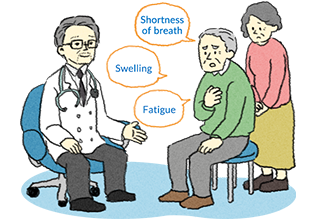What are the Symptoms of Heart Failure?
Watch out for swelling and shortness of breath, in addition to lethargy and fatigue.
Symptoms seen in the early stages of heart failure include swelling, which results in an indentation when a finger is pressed on the front of the lower leg, ankle, or instep of the foot, and shortness of breath when climbing a slope or stairs.
During heart failure, fluid accumulates throughout the body, leading to weight gain (an increase of 2-3kg or more) and coughing or difficulty breathing when lying down.
Symptoms may also include lethargy and fatigue. Keep an eye out for these symptoms, check your weight every day, and if it increases by 2-3kg or more in a week, consult a family doctor or specialist as soon as possible.
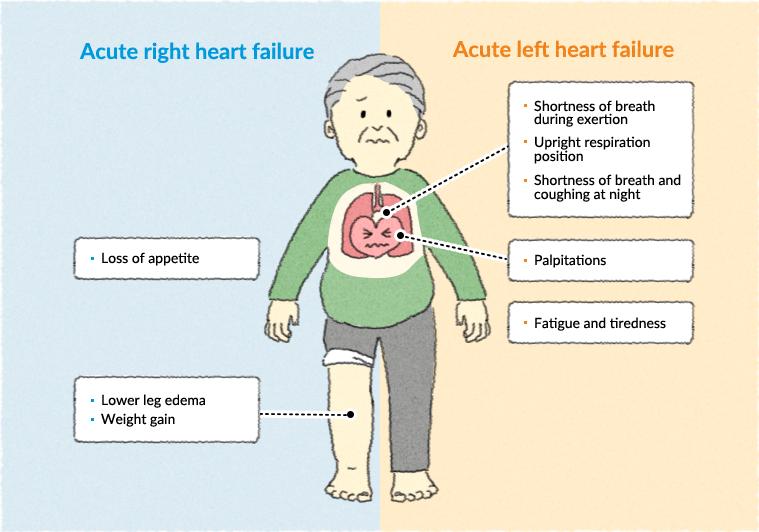
In addition, there may be signs such as jugular vein distention, pleural effusion(also known as water on the lungs), or hepatomegaly(abnormal enlargement of the liver).
Jugular vein distention
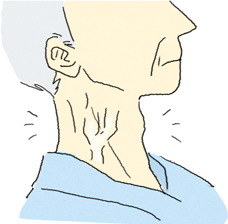
This is caused by an impairment of the return of blood to the right side of the heart. Check by sitting with your upper body at a 45-degree angle. Jugular vein distention (the bulging of the veins in the neck) is a useful indicator of elevated pressure in the right atrium.
Bulging of the external jugular vein close to the surface of the body is easy to observe, but it is the pulsation of the internal jugular vein that more accurately reflects the pressure in the right atrium.
Pleural effusion (water on the lungs)
Due to the rise in capillary pressure, fluid is retained in the thoracic cavity (chest cavity).
Normally, pleural effusion occurs in the lower part of the thoracic cavity; in the chest x-ray shown, a shadow caused by body fluids accumulating at the bottom of the lung (light blue area in the figure) can be seen. As the amount of fluid increases, the shadow expands upward.
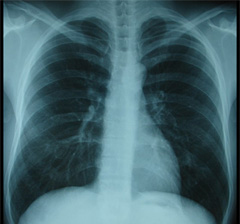
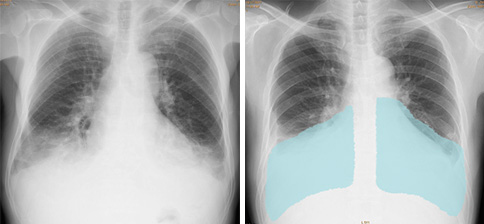
Hepatomegaly (enlarged liver)
In cases of hepatomegaly, the liver is swollen to the extent that it can be felt by touch below the rib cage.
Hepatomegaly results in tenderness, abdominal swelling, and pressure on the right upper abdomen.
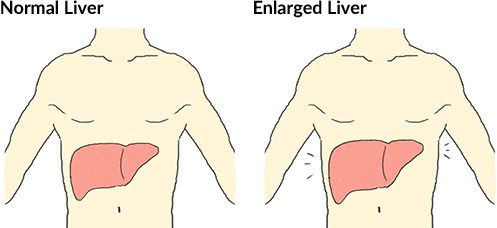
Please consult your doctor or specialist if you have these symptoms
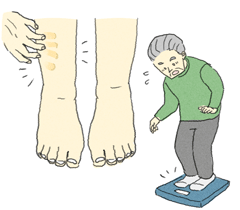
This happens as the volume of blood flowing to the kidneys decreases, the amount of urine decreases, and fluid accumulates in the body.
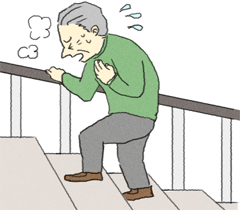
This happens when the heart is unable to pump enough blood, resulting in the body not getting enough oxygen or nutrients.
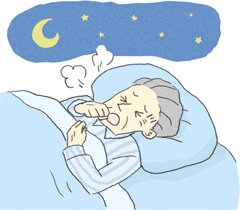
This happens due to the progression of blood congestion in the body (hypostasis).
How the heart works
What causes shortness of breath, swelling, and fatigue?
- 1A healthy system
The heart is slightly to the left of the center of the chest, is made wholly of muscle, and works as a pump to move blood around the body. It is divided into 4 chambers: those in the upper part are called the atria, and those in the lower part are called the ventricles. The atria and the ventricles contract at different times. Because the atria and ventricles are divided into left and right respectively, they are called the left atrium, left ventricle, right atrium, and right ventricle. Each chamber of the heart has a valve, and the heart is structured so that blood does not flow backwards.
- 2Shortness of breath
The heart is unable to pump sufficient blood and cannot handle the volume of blood coming in from the lungs, leading to hypostasis causing blood to stagnate in the body. As the congestion progresses, it places a burden on the lung in front of the left side of the heart, and as fluid accumulates in the lungs, it causes shortness of breath.
- 3Swelling
In a situation where insufficient blood is sent to the lungs (hypostasis = congestion), a burden is placed on the right side of the heart, and on the area surrounding the vessels that transport blood to the lower body, which are located in front of the lungs.
Also, because the heart cannot pump enough blood, the flow of blood to the kidneys is reduced, the amount of urine decreases, and swelling occurs because the body cannot excrete the accumulated fluid. - 4Lethargy
When the heart cannot send enough blood to the organs, symptoms of lethargy or fatigue are observed.






